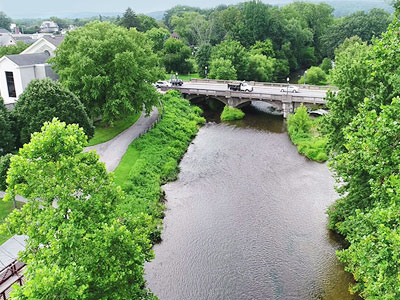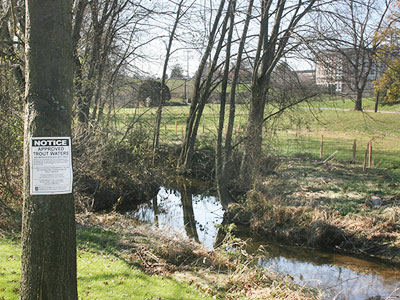The plants and trees in a riparian buffer absorb stormwater and filter pollutants before the runoff enters the watershed.
Without healthy riparian buffers, streambank erosion can occur and damage structures, roads, and agricultural land.
How it Works
Riparian buffers include vegetation such as trees, shrubs and other vegetation adjacent to a body of water. Riparian buffers help to maintain the integrity of stream channels and reduce the impact of pollution by filtering out sediments, nutrients and other chemicals. Preserving and restoring riparian buffers are among the most effective techniques used to protect and enhance the quality of groundwater and surface water. Buffers also supply habitat, food, cover, and thermal protection to fish and other wildlife. Riparian buffers protect waterways from the impact of human activities such as farming, animal grazing, lumbering, mining, and development. The vegetation of the buffer intercepts polluted and sediment-laden stormwater running off the land surface before it reaches the water body.
Buffers are most critical in watershed headwater areas and smaller first and second order streams. Buffers along the wider downstream portions of a watershed are important, especially for fisheries, wildlife habitats, and flood storage but have proportionately less impact on water quality.
Historically, forests and riparian buffers protected most of the streams and creeks in Chester County. Deforestation associated with agriculture, industry, and urban expansion over the past 300 years has drastically reduced the extent of streambanks protected by a buffer. This tool describes techniques local municipalities can use to create new buffers, as well as preserve and maintain existing buffers.
Benefits
Streambank Stabilization
The root systems of trees and shrubs hold soil in place, helping to stabilize streambanks and reduce erosion. Severe streambank erosion can damage structures, roads, and agricultural land.
Peak Storm Flow Reduction
Stormwater runoff can be slowed and infiltrated in a forested riparian buffer, helping to reduce peak flow of water in a stream during a storm event. Well-established vegetation growing along a streambank reduces the velocity of flowing water, making it less damaging to structures.
Pollutant Filtration
Pesticides and other pollutants contained in stormwater runoff can be detained by riparian buffer tree leaf litter and upper layers of the soil where beneficial bacteria and exposure to the atmosphere help break pollutants down into less harmful components.
Natural Habitat Preservation
Streams that travel through woodlands provide necessary habitats for fish and wildlife. Tree branches and limbs that fall across or into the stream serve as cover for fish, and provide woody debris needed to support aquatic invertebrates. Buffers also provide habitat and travel corridors for terrestrial animals. Leaves that fall into a stream and are trapped on woody debris and rocks provide food and habitat for small bottom-dwelling creatures critical to the food chain.
Increased Nutrient Uptake
Nutrients such as nitrate and phosphate that originate from activities on the land can be detained by leaf litter and the soil, and then taken up by the roots of vegetation and stored in leaves, limbs, and roots. If vegetation is not present to detain and take up these nutrients, they travel in stormwater runoff, reaching the stream and negatively affecting aquatic organisms.
Water Temperature Regulation
The leaf canopy of a tree-lined stream provides shade that keeps water cool. Cooler water retains more dissolved oxygen, which is needed by fish, and encourages the growth of the diverse types of algae and aquatic insects that are part of a healthy food chain. Trout are known to not be able to tolerate increases in water temperature associated with the absence of streamside trees.
Energy Conservation
Riparian buffers reduce the thermal loading of streams, as well as the potential for erosion, pollution, and flooding. This allows streams to carry out their natural functions, thus reducing energy demands associated with repairing the damage associated with these issues or mitigating the absence of the riparian buffer with built infrastructure.

Municipalities can manage stream corridor buffers through non-regulatory and regulatory processes.
Get Started
There are a variety of ways to preserve and protect riparian buffers during the land development process and through normal land use activities. Municipalities can manage stream corridors and their buffers through both non-regulatory and regulatory processes. Active planning and involvement by the local municipal government can be very effective in conserving this critical component of the natural environment.
Establish Policy
Municipal policy planning such as a formal comprehensive plan or an adopted open space and recreation plan is the most direct process for establishing conservation policy. These plans can contain maps, inventories, and descriptions of the streams and riparian areas in a municipality, and goals and objectives for their conservation.
Resource Inventory
The municipal policy plan should include an inventory which describes and maps riparian buffers in the municipality. Riparian buffers within a municipality should be inventoried and mapped as an individual map and/or coverage in the municipal Geographic Information System (GIS) to provide a general idea of the location of the riparian buffers.
Regulatory Techniques
Municipalities can provide for the health, safety and welfare of their communities by regulating land use activities to preserve and protect riparian buffers. Property owners can be required to submit conservation plans to the municipality for approval before substantial land disturbance commences.
Develop and Adopt Ordinance Standards: After a policy basis is established, a municipality should amend its zoning ordinance to include riparian buffer protection standards or maximum disturbance limits, and specified activities permitted in these buffers. The subdivision and land development ordinance should require site specific identification of riparian buffers to be conducted as part of the land development process. Strategies may include provisions being added to the preliminary and final plan requirements of the subdivision and land development ordinance to require such studies.
The following are regulations that municipalities should implement to best protect riparian buffers:
- Ideally the full extent of the buffer from each side of the stream should be 100 feet in width, but at least 75 feet wide.
- Two-tier buffers work well with the strictest disturbance limitation applied to the buffer next to the stream. Two-tiered buffers should include a 25 to 35 foot-wide inner buffer in which disturbance is prohibited or very limited, and a 50 to 65 foot-wide outer buffer in which a maximum disturbance limit of 20% is permitted.
- Buffers should be extended further if the stream is located adjacent to very steep slopes.
- Tree planting within non-forested buffers can be mandated through the subdivision/land development process.
- In communities containing Special Protection Waters (including any Exceptional Value or High Quality Stream), regulations should require the establishment of a riparian buffer in accordance with the PA Department of Environmental Protection's Chapter 102. The most restrictive ordinance standard would apply when there are overlapping regulations for Special Protection Waters.
- In heavily urbanized areas, the standards may need additional consideration and flexibility to enable enforcement.
Zoning Considerations: Zoning ordinances can protect riparian buffer zones in a number of ways. Beyond the natural resource protection standards listed above, municipalities can implement zoning to set development patterns that further encourages natural resource protection. For example, cluster zoning, or Transfer of Development Rights (TDR) are suggested methods of protecting riparian buffer zones by directing growth toward land most suitable to be developed while preserving areas of land containing high value natural resources.
Non-regulatory Techniques
Municipalities may request "riparian easements" from developers or land owners. This easement gives the municipality access to the property to create and maintain buffer areas. Municipal governments can also cooperate with the Chester County Conservation District and local watershed protection groups to help inform riparian landowners about best management practices that protect buffers. Municipalities can also encourage landowners to sell or donate riparian conservation easements to a land trust, and provide funds and/or in-kind assistance for local stream restoration projects. Acquisition of riparian lands and/or conservation easements by the municipality can be an important part of implementing municipal policy plans.
Other non-regulatory activities for conserving riparian buffers in which local municipalities can participate include providing support for municipal Agricultural Security Areas, farmland preservation, open space preservation, and the use of conservation plans.
Review Established Standards
Some riparian buffers can be protected by existing natural feature regulations, such as floodplain, steep slope, wetland, and woodland ordinances, but these regulations by themselves are not as effective for protecting riparian areas as a riparian buffer ordinance.
For existing riparian buffer protection standards, a full review of the ordinance should be undertaken to determine the best approach for updating or expanding the resource protection standards to address modern environmental best practices. Depending on the strength of the current standards, amendments to fill in the gaps and add more specific protection criteria may be all that is required. Otherwise, a full update and reorganization of the protection standards may be needed.
Ordinance Organization
A well-organized ordinance makes it easier to enforce the provisions, avoid inconsistencies, and provide a clearer understanding of resource protection requirements for municipal officials, landowners, and developers. The most efficient means of organizing natural resource standards in municipal regulations is to include an umbrella approach to natural resources addressing riparian buffers as well as wetlands, steep slopes, and woodlands in a single article of the ordinance. The riparian buffer standards should be clearly defined and placed in one location in the ordinance, rather than several different sections.
Cooperation among government agencies, adjacent municipalities, conservation organizations, and land trusts may be needed to establish continuous buffers along streams.
Considerations
Resident Outreach
Outreach may be necessary to inform residents of regulations and best management practices for riparian buffers. For example, residents may be unaware of the importance of riparian buffers and the associated lawn management necessary to protect these buffers. Residents may need to be instructed how to restore riparian buffers on their property, and encouraged not to mow to the edge of the streambank.
Permitted Activities
Municipal regulations should specify which types of activities are permitted in riparian buffers. Permitted activities may include low intensity uses such as recreation and natural trails. Active and passive recreation uses should be evaluated to ensure that permitted activities do not cause detrimental disruption to riparian buffers.
Ordinance Flexibility
While there is scientific evidence to support local ordinances which prohibit the removal of trees and disturbance of other vegetation within 75 to 100 feet of a water body or wetland, prohibiting all land disturbance or tree and vegetation removal in a wider buffer (such as a 150-foot width buffer) may be too restrictive. Local ordinances requiring riparian buffers need to be flexible to allow consideration for specific municipal conditions and site characteristics.
Encourage Continuous Protection
For effective protection, riparian buffers should be protected continuously along the waterbody, and should extend into neighboring municipalities. The cooperation and assistance of government agencies, adjacent municipalities, conservation organizations, and land trusts may be needed to establish corridors or networks of streams possessing continuous buffers.

Pennsbury Township's subdivision and land development ordinance provides an array of riparian buffer standards.
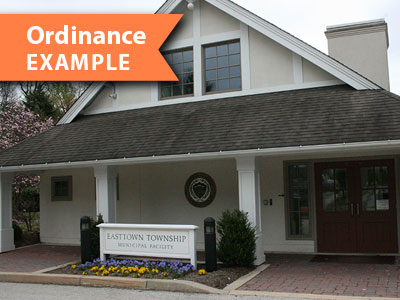
Easttown Township has riparian buffer provisions appropriate for a more developed community.
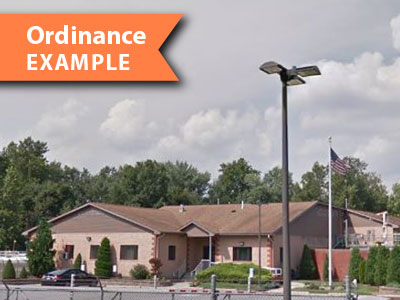
North Coventry Township's regulations relate to grading, erosion and sediment control and storm water management.

Pocopson Township regulates riparian buffers in a two zone approach, where no disturbance is permitted in Zone 1, and no more than 15% disturbance is permitted in Zone 2.
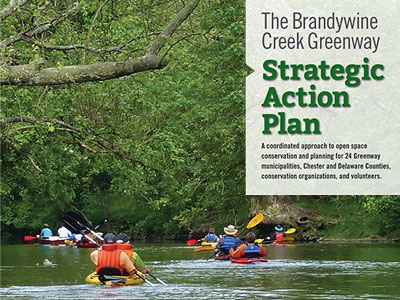
Model Resource Protection Ordinance
The Chester County Planning Commission partnered with the Brandywine Conservancy in 2015 to develop a set of natural resource protection standards to support the Conservancy's Brandywine Creek Greenway initiative. The Natural Resource Protection standards provide a template and background information for addressing natural resource protection through municipal ordinances. The model standards are located in The Brandywine Creek Greenway Strategic Action Plan Part 3 — Toolkit starting on page 327. Specific riparian buffer standards start on page 343. Additional forested riparian buffer standards that provide a higher level of protection are located in the same document starting on page 363.





